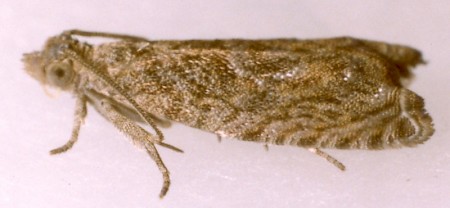49.255 BF1138
Epinotia nisella
(Clerck, 1759)
Wingspan 12-17 mm.
This very variable species is widely distributed and fairly common throughout Britain. There are many variations, though one of the more distinctive is f. decorana, which shows an orange area over the mid-part of the forewing.
The larvae feed on sallow (Salix) and poplar (Populus) during the spring, and the adults emerge in July and August.
Larva: (description Ian F. Smith)
Foodplant: Salix and Populus. In catkins or between two leaves spun flat together.
Early instar:
Length: 6 mm.
Head: Pitchy black. Adfrontal sutures thin dark brown line, adfrontal area mid brown. Mouthparts reddish brown dorsally, whitish ventrally.
Prothorax (T1): Prothoracic shield translucent blackish grey with black spots, darker at posterior; divided by whitish grey median line; whitish band at anterior; posterior edge thinly lined whitish grey. Large, shiny grey prespiracular pinaculum and subventral pinaculum.
Mesothorax (T2): Whitish grey. Shiny grey pinacula, larger than those on abdomen: one pair dorsal; one lateral; two at spiracle level, the anterior smaller and offset lower than the posterior one; one subventral.
Metathorax (T3): As T2.
Thoracic legs: Base coloured as abdomen with grey mark at posterior. Femur and tibia pitchy black. Tarsus pale brown.
Body: Matt yellowish white, slightly translucent, allowing viscera to darken thorax and abdominal segments 1 to 6 to greyish white.
Spiracles: Peritreme brown.
Abdominal pinacula: Shiny grey. Two pairs on dorsum, the posterior more widely spaced than the anterior pair; one lateral; one subspiracular, one subventral.
Setae: Whitish. Large pair on anal plate pale brownish basally.
Anal segment (A10): Whitish with rough surface. Imperceptibly sclerotised.
Prolegs: Coloured as abdomen. Planta whitish. Crochets reddish brown.
Late instar:
Length: 9 mm.
Head: Frons light brown. Capsule light brown anterior and blotchy dark brown posterior. Adfrontal sutures thin dark brown line. Adfrontal area mid brown. Mouthparts reddish brown dorsally, whitish ventrally. Stemmatal area black. Black mark on ventral surface postero-laterally.
Prothorax (T1): Prothoracic shield shiny translucent brownish white darkened by body below, with transparent marks variously showing brown or dark brown of head or body below. Divided by whitish median line. Whitish transparent band at anterior; posterior edge thinly lined transparent colourless. Large, shiny light grey, prespiracular pinaculum and subventral pinaculum.
Mesothorax (T2): Whitish grey. Shiny grey pinacula, larger than those on abdomen: one pair dorsal; one lateral; two at spiracle level, the anterior smaller and offset lower than the posterior one; one subventral.
Metathorax (T3): As T2.
Thoracic legs: Base coloured as abdomen with grey mark at posterior. Femur and tibia greyish. Tarsus pale brown.
Body: Matt yellowish white, slightly translucent, allowing viscera to darken thorax and abdominal segments 1 to 6 to greyish white.
Spiracles: Peritreme brown.
Abdominal pinacula: Shiny light grey. Two pairs on dorsum, the posterior more widely spaced than the anterior pair; one lateral; one subspiracular, one subventral.
Setae: Whitish.
Anal segment (A10): Whitish with transparent marks appearing slightly darker. Imperceptibly sclerotised.
Prolegs: Coloured as abdomen. Planta whitish. Crochets reddish brown.

 UKMoths
UKMoths 





